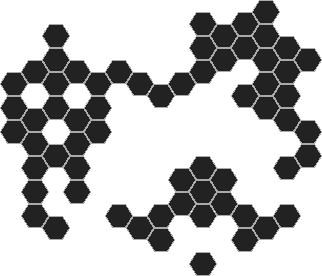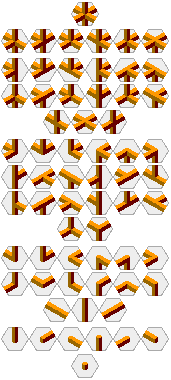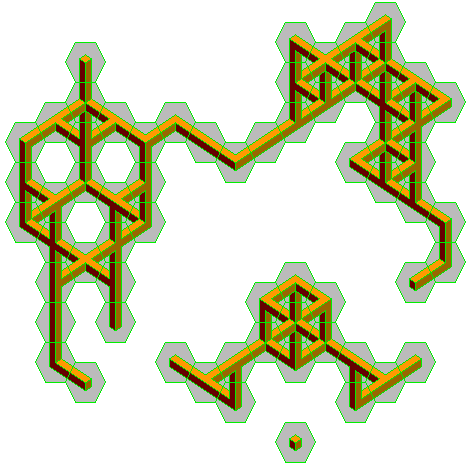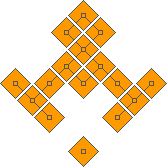 | The China Labyrinth was conceived in the early eighties by Martin Medema who was first to imagine 64 hexagons in a configuration wherein each would differ from all others in terms of the configuration of neighbours around it. That was brilliant. That he constructed one with unmarked draughtsmen bears witness to his tenacity. It required keeping a very elaborate administration, because adding one man to the lay-out inevitably changes the configuration around all its neighbours. But he succeeded, eventually, and although it is not the actual solution he found, it might have looked something like this. There are unfathomable many solutions, all sharing the labyrinth's defining property: every hexagon is unique in terms of the configuration its neighbours form around it. Thus there's one hexagon with 6 neighbours and one with none at all. There are six with 5 neighbours, all missing a neighbour in a different position, and six with just 1 neighbour, all in a different position. Dare I say: 'And so on'? |
| I'm not as tenacious as Martin, but I figured that if you marked the draughtsmen with a fixed arrow for orientation, and the 64 patterns as lines radiating from the center, you could create what was later to be termed a 'transcendental solution' in a quarter of an hour instead of a week. Now, to get a 'transcendental solution', all beams must simply find a hexagon with a matching one, and all blank edges must border on blank space. Thus solutions started pouring in.
It was soon discovered and proven that the number of seperate groups (the blank counting as one group) will always equal the number of loops (holes in the solution). The minimum number of groups (loops) is two. The theoretical maximum is eight, but no solution above seven has ever been found. Solutions may come in several symmetries: orthogonal, diagonal and rotational (with 16, 8 and 4 symmetric pieces respectively). Rotational symmetric solutions always have six groups. The above solution is, as far as the big group is concerned, a 'free' solution without any kind of symmetry. |
 |
 | It was made using a sophisticated '3-D' set in Penrose display, in which the orientation is inherently given by the 'lightfall'. Note that polygons with an odd number of sides are 'impossible', while those with an even number of sides are 'possible'. Note also that the beam-structure does not add any information: the hexagons can always be identified by their neighbours alone, the essence of a 'transcendental solution'. Read more about: |
PS. did you spot the hidden square solution?
 |  |
The China Labyrinth © MindSports
